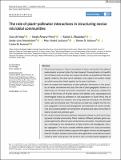Por favor, use este identificador para citar o enlazar a este item:
http://hdl.handle.net/10261/246304COMPARTIR / EXPORTAR:
 SHARE SHARE
 CORE
BASE CORE
BASE
|
|
| Visualizar otros formatos: MARC | Dublin Core | RDF | ORE | MODS | METS | DIDL | DATACITE | |

| Título: | The role of plant–pollinator interactions in structuring nectar microbial communities |
Autor: | Vega, Clara de CSIC ORCID; Álvarez-Pérez, Sergio; Albaladejo, Rafael G.; Steenhuisen, Sandy-Lynn; Lachance, Marc-André; Johnson, Steven D.; Herrera, Carlos M. CSIC ORCID | Palabras clave: | Beetles Floral microbiome Insects Multi-trophic interactions Nectar bacteria Nectar yeasts Pollination South Africa |
Fecha de publicación: | 2021 | Editor: | British Ecological Society | Citación: | Journal of Ecology, (2021) | Resumen: | 1. Floral nectar harbours a diverse microbiome of yeasts and bacteria that depend predominantly on animal visitors for their dispersal. Since pollinators visit specific sets of flowers and carry their own unique microbiota, we hypothesize that plant species visited by the same set of pollinators may support non-random nectar microbial communities linked together by the type of pollinator. 2. Here we explore the importance of plant–pollinator interactions in the assembly of nectar microbiome and study the role of plant geographic location as a determinant of microbial community composition. We intensively sampled the nectar of 282 flowers of 48 plant species with beetles, birds, long-tongued and short-tongued insects as pollinators in wild populations in South Africa, one of the world's biodiversity hotspots, and using molecular techniques we identified nectar yeast and bacteria taxa. The analyses provided new insights into the richness, geographic structure and phylogenetic characterization of nectar microbiome, and compared patterns of composition of bacteria and yeast communities in relation to plant and pollinator guild. 3. Our results showed that plant–pollinator interactions played a crucial role in shaping nectar microbial communities. Plants visited by different pollinator guilds supported significantly different yeast and bacterial communities. The pollinator guild also contributed to the maintenance of beta diversity and phylogenetic microbial segregation. The results revealed different patterns for yeast and bacteria; whereas plants visited by beetles supported the highest richness and phylogenetic diversity of yeasts, bacteria communities were significantly more diverse in plants visited by other insect groups. We found no clear microbial spatial segregation at different geographical scales for bacteria, and only the phylogenetic similarity of yeast composition was correlated significantly with geography. 4. Synthesis. Interactions of animal vector, plant host traits and microbe physiology contribute to microbial community assemblages in nectar. Our results suggest that plants visited by the same pollinator guild have a characteristic nectar microbiota signature that may transcends the geographic region they are in. Contrasted patterns for yeast and bacteria stress the need for future work aimed at better understanding the causes and consequences of the importance of plants and pollinators in shaping nectar microbial communities in nature. | Versión del editor: | https://doi.org/10.1111/1365-2745.13726 | URI: | http://hdl.handle.net/10261/246304 | DOI: | 10.1111/1365-2745.13726 |
| Aparece en las colecciones: | (EBD) Artículos |
Ficheros en este ítem:
| Fichero | Descripción | Tamaño | Formato | |
|---|---|---|---|---|
| Herrera in press.pdf | 2,66 MB | Adobe PDF |  Visualizar/Abrir |
CORE Recommender
SCOPUSTM
Citations
15
checked on 20-abr-2024
WEB OF SCIENCETM
Citations
12
checked on 24-feb-2024
Page view(s)
99
checked on 27-abr-2024
Download(s)
176
checked on 27-abr-2024
Google ScholarTM
Check
Altmetric
Altmetric
Este item está licenciado bajo una Licencia Creative Commons

